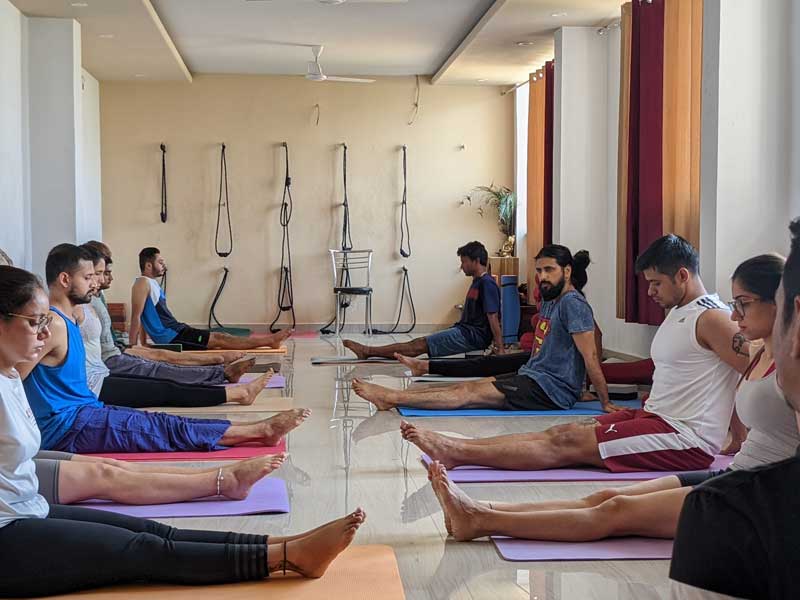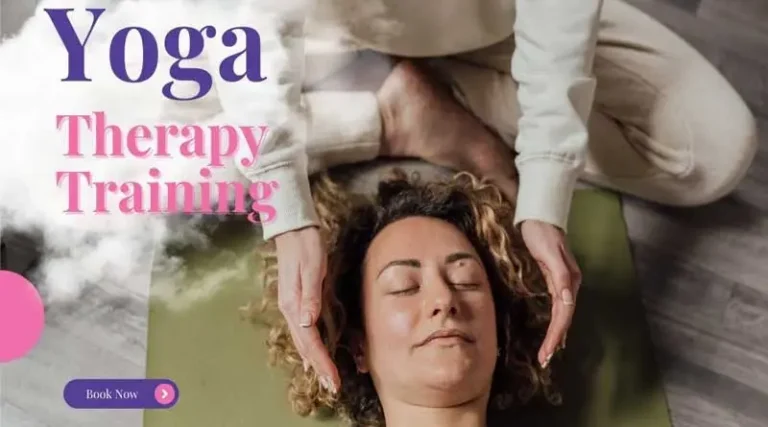
Introduction to Sciatica
Yoga for Sciatica – Sciatica is a condition that causes pain, numbness, or tingling. This happens along the sciatic nerve.
The sciatic nerve runs from the lower back, through the hips, and down each leg. This discomfort can range from mild to severe. A herniated disc, spinal stenosis, or tight muscles often cause it by pressing on the nerve.
Yoga is a natural and effective way to manage sciatic pain. It helps stretch and strengthen the muscles in the lower back and hips.
Yoga poses for sciatica pain
Yoga provides a combination of stretching, strengthening, and relaxation techniques that:
- Reduce tension in the lower back, hips, and legs.
- Improve circulation and flexibility.
- Strengthen core muscles to support the spine.
- Enhance body awareness to prevent future flare-ups.
- Promote relaxation, reducing stress-related muscle tightness.
Precautions Before Practicing Yoga for Sciatica
- Always talk to a healthcare professional before starting yoga for sciatica. This is important if you have severe pain or any other health issues.
- Avoid deep forward bends, extreme twists, or poses that cause pain.
- Move slowly and mindfully to avoid overstretching.
- Use props like yoga blocks and bolsters for added support.
Best yoga asanas for sciatica
Here are some of the most effective yoga asana for sciatica pain:
1. Child’s Pose (Balasana)
Child’s Pose (Balasana) is a soothing forward bend that alleviates sciatica discomfort by stretching the lower back, hips, and gluteal muscles. It helps ease spinal tension and encourages relaxation. Nevertheless, if a herniated disc is the source of sciatica, intense forward bending could exacerbate the symptoms.
- Kneel on the floor, bringing your large toes together and separating your knees slightly.
- Stretch your arms ahead and bring your torso down to the mat.
- Rest your forehead on the floor and breathe deeply.
- This pose gently stretches the lower back and hips, relieving tension around the sciatic nerve.
2. Downward-Facing Dog (Adho Mukha Svanasana)
Downward-Facing Dog can help relieve sciatica pain by stretching the hamstrings, calves, lower back, and spine, improving flexibility and reducing nerve tension. However, if hamstrings are too tight, it may pull on the lower back, worsening pain.
- Start in a tabletop position with hands and knees on the mat.
- Lift your hips upward, straightening your legs to form an inverted V shape.
- Press your heels toward the floor while keeping your spine lengthened.
- This pose stretches the hamstrings, calves, and lower back, reducing sciatic nerve compression.
3. Pigeon Pose (Eka Pada Rajakapotasana)
The Pigeon Pose serves as an effective stretch for the hips, glutes, and lower back, making it a beneficial practice for alleviating sciatica discomfort linked to a tight piriformis muscle. Nonetheless, caution is advised, as it could potentially exacerbate symptoms in cases of nerve compression.
- From a tabletop position, bring your right knee forward and place it behind your right wrist.
- Extend your left leg straight back and rest your hips toward the floor.
- Keep your torso upright or fold forward for a deeper stretch.
- This pose targets the piriformis muscle, a common cause of sciatic pain.
4. Reclining Figure-Four Stretch (Supta Kapotasana)
The Reclining Figure-Four Stretch is a soothing and beneficial position that alleviates sciatica discomfort by gently stretching the piriformis muscle, glutes, and lower back without putting too much pressure on the body. This stretch aids in relieving tension that might be pinching the sciatic nerve.
- Lie on your back and cross your right ankle over your left thigh.
- Thread your hands through your legs and gently pull your left thigh toward your chest.
- Hold for 30-60 seconds and switch sides.
- This stretch helps release tension in the hips and lower back.
5. Seated Forward Fold (Paschimottanasana)
- Sit with your legs extended straight in front of you.
- Hinge at your hips and reach toward your feet, keeping your spine long.
- Hold for 30 seconds, breathing deeply.
- This stretch relieves tension in the hamstrings and lower back, reducing sciatic pain.
6. Cat-Cow Stretch (Marjaryasana-Bitilasana)
- Begin in a tabletop position with your hands under your shoulders and knees under your hips.
- Inhale, arch your back, lifting your head and tailbone (Cow Pose).
- Exhale, round your spine, tucking your chin and pelvis (Cat Pose).
- Repeat for 1-2 minutes to improve spinal flexibility and relieve nerve compression.
7. Bridge Pose (Setu Bandhasana)
- Recline on your back, bending your knees and keeping feet hip-distance apart.
- Press into your feet and lift your hips, engaging your glutes and core.
- Hold for 30 seconds, then slowly lower.
- This pose strengthens the lower back and stabilizes the spine.
8. Upward facing dog pose sciatica
Upward Facing Dog is a backbend and spinal extension pose that stretches the front body while strengthening the back. For people with sciatica, this pose can help or make things worse. It depends on what is causing the nerve pain.
Yoga Sequence for Sciatica Relief
To effectively relieve sciatic nerve pain, practice the following the 8 yoga poses for sciatica pain:
- Child’s Pose – 1 minute
- Cat-Cow Stretch – 1-2 minutes
- Downward-Facing Dog – 30 seconds
- Pigeon Pose (both sides) – 1 minute per side
- Reclining Figure-Four Stretch – 30 seconds per side
- Seated Forward Fold – 30 seconds
- Bridge Pose – 30 seconds
Additional Tips for Managing Sciatica
- Maintain good posture when sitting and standing.
- Avoid prolonged sitting; take breaks to move and stretch.
- Engage in gentle physical activities like walking or swimming.
- Use a firm mattress and proper sleeping posture to support spinal alignment.
- Stay consistent with yoga practice to maintain flexibility and strength.
Is yoga good for sciatica pain
Yoga can help relieve sciatica pain. However, how well it works depends on what causes your pain and the poses you use.
How Yoga Helps with Sciatica Pain
Releases Muscle Tension – Doing yoga can help reduce tightness in the lower back, hips, and hamstrings. This can ease pressure on the sciatic nerve.
Enhances Spinal Alignment – Maintaining correct posture and spinal alignment helps minimize nerve compression.
Builds Core and Back Strength – A strong core helps support the lower back. This can prevent more irritation of the sciatic nerve.
Increases Flexibility and Range of Motion – Gentle yoga movements promote circulation and reduce stiffness.
Encourages Relaxation – Deep breathing and mindfulness can reduce stress. This may help you manage how you feel pain.
yoga poses to avoid with sciatica
If you suffer from sciatica, certain yoga positions may exacerbate your discomfort by increasing pressure on the sciatic nerve. Avoiding poses that strain the lower back, stretch the hamstrings too much, or twist the spine sharply is important.
Yoga Positions to Avoid with Sciatica
1. Forward Bends (Both Standing and Sitting)
– Standing Forward Fold (Uttanasana)
– Seated Forward Bend (Paschimottanasana)
– Downward-Facing Dog (Adho Mukha Svanasana) – Particularly if Hamstrings Are Tight
– Reason for Avoidance: These positions can overly stretch the hamstrings, which can pull on the sciatic nerve and heighten pain.
2. Deep Twists
– Revolved Triangle Pose (Parivrtta Trikonasana)
– Revolved Chair Pose (Parivrtta Utkatasana)
– Reason for Avoidance: Engaging in deep twisting movements can compress the lower back, leading to increased nerve discomfort.
3. Severe Backbends
– Wheel Pose (Urdhva Dhanurasana)
– Full Cobra Pose (Bhujangasana with Locked Elbows)
– Upward-Facing Dog (Urdhva Mukha Svanasana) – Especially if Pain Persists
– Reason for Avoidance: These poses can stretch the lower back too much. This may worsen sciatic pain, especially if it comes from spinal compression.
4. Poses That Overstretch Hips and Glutes
– Deep Pigeon Pose (Eka Pada Rajakapotasana) – If It Induces Nerve Pain
– Cow Face Pose (Gomukhasana)
– Reason for Avoidance: These poses can put a lot of stress on the piriformis muscle. This may worsen the pressure on the sciatic nerve.




